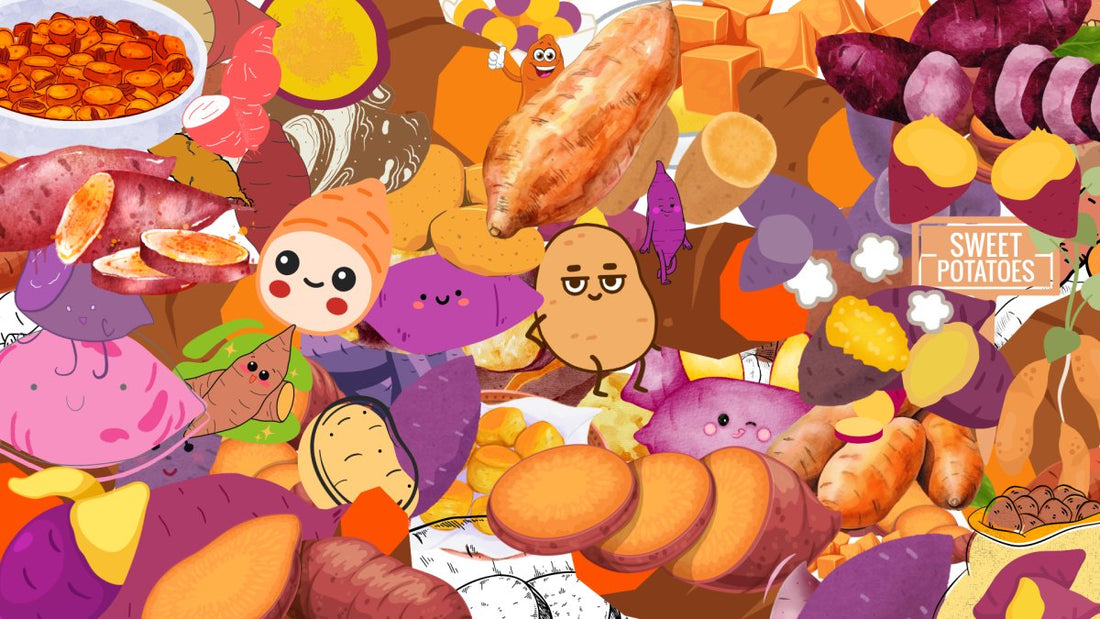Welcome to the wonderful world of sweet potatoes! These delicious and nutritious root vegetables have been delighting taste buds for centuries, and there's so much more to them than meets the eye. From their rich history to their surprising health benefits, sweet potatoes are a versatile and fascinating food. So, let's dive in and uncover 50 fun facts about sweet potatoes that will leave you craving more!
- Sweet potatoes are not actually potatoes! They belong to the morning glory family, while regular potatoes belong to the nightshade family.
- There are over 400 different varieties of sweet potatoes, ranging in color from orange and purple to white and even yellow.
- The orange-fleshed sweet potato is often called a "yam" in the United States, but it's actually a sweet potato. True yams are starchier and drier than sweet potatoes and are more common in Africa and Asia.
- Sweet potatoes are one of the oldest vegetables known to man, with origins dating back thousands of years to Central and South America.
- They were first domesticated around 5,000 years ago in what is now Peru.
- Christopher Columbus introduced sweet potatoes to Europe after his voyages to the Americas in the late 15th century.
- Sweet potatoes were also a staple food for early American settlers, including the Pilgrims, who likely enjoyed them at the first Thanksgiving in 1621.
- George Washington grew sweet potatoes at Mount Vernon, and Thomas Jefferson had them served at the White House during his presidency.
- Sweet potatoes are highly nutritious and are packed with vitamins A, C, and B6, as well as fiber, potassium, and antioxidants.
- The orange-fleshed varieties of sweet potatoes are particularly rich in beta-carotene, which the body converts into vitamin A.
- Sweet potatoes are naturally gluten-free, making them an excellent option for those with gluten sensitivities or celiac disease.
- Despite their sweet taste, sweet potatoes have a relatively low glycemic index, which means they won't cause a rapid spike in blood sugar levels.
- In addition to being eaten fresh, sweet potatoes can be dried into jerky and ground into flour.
- Sweet potato leaves are also edible and are commonly used in African and Asian cuisines, either raw in salads or cooked as a leafy green vegetable.
- Sweet potatoes are a versatile ingredient and can be prepared in numerous ways, including roasting, baking, boiling, steaming, and even grilling.
- In the United States, sweet potatoes are often enjoyed as a side dish at Thanksgiving, either mashed, baked, or in a sweet potato casserole topped with marshmallows.
- In Japan, sweet potatoes are often roasted whole and sold as a popular street food known as "yaki-imo."
- In Korea, sweet potatoes are used to make a popular snack called "goguma-mattang," which consists of caramelized sweet potatoes coated in sugar.
- Sweet potato fries have become a trendy alternative to regular French fries, offering a slightly sweet and crispy twist on a classic favorite.
- Sweet potato pie is a traditional Southern dessert that is similar to pumpkin pie but made with mashed sweet potatoes, sugar, spices, and eggs.
- Sweet potatoes can be used to make a variety of beverages, including sweet potato smoothies, lattes, and even sweet potato beer!
- In some parts of Africa, sweet potatoes are fermented to make a traditional alcoholic beverage called "amabere."
- Sweet potato vines are often used as animal feed for livestock, particularly in regions where sweet potatoes are grown extensively.
- Sweet potatoes are grown in over 100 countries worldwide, with China being the largest producer, followed by Nigeria and Uganda.
- The world record for the heaviest sweet potato weighs in at a whopping 81 pounds, grown by Peter Glazebrook in the UK in 2010.
- Sweet potatoes are considered a drought-tolerant crop and are often grown in regions with poor soil quality or limited water resources.
- The leaves of sweet potato plants can help suppress weeds and improve soil health when used as mulch or compost.
- Sweet potatoes are an important crop for food security in many developing countries, providing a reliable source of nutritious food during times of scarcity.
- In some cultures, sweet potatoes are believed to have medicinal properties and are used to treat ailments such as coughs, colds, and digestive issues.
- Sweet potato starch is used in the production of biodegradable plastics, making it an eco-friendly alternative to petroleum-based plastics.
- Sweet potatoes have a long shelf life and can be stored for several months under the right conditions, making them a valuable food source during winter months or times of food shortages.
- The leaves and stems of sweet potato plants are sometimes used as natural dyes, producing shades of green, yellow, and purple.
- Sweet potatoes are an excellent source of energy for athletes and active individuals, providing a steady supply of carbohydrates to fuel workouts and replenish glycogen stores.
- Sweet potato vines are often used in landscaping and gardening as ornamental plants, adding a pop of color to gardens and landscapes.
- Sweet potatoes are a sustainable crop, requiring less water and fertilizer than many other staple crops such as rice, wheat, and corn.
- The flowers of sweet potato plants are edible and can be used to add a touch of color and flavor to salads and other dishes.
- Sweet potatoes are an important crop for small-scale farmers in developing countries, providing them with a source of income and food security.
- Sweet potato fries were popularized in the United States in the 20th century and have since become a beloved side dish at restaurants and fast-food chains nationwide.
- Sweet potatoes are often used in vegan and vegetarian cooking as a nutritious and flavorful alternative to meat.
- Sweet potato skins are edible and are a good source of fiber, so don't throw them away – try roasting them for a crispy snack. At THEO's, we keep the skin on!
- Sweet potato vines are sometimes used in traditional medicine to treat skin conditions such as eczema and psoriasis.
- Sweet potatoes are a popular baby food due to their mild flavor and soft texture, making them easy for little ones to eat and digest.
- Sweet potatoes are an important part of Thanksgiving celebrations in the United States and are often featured in dishes such as sweet potato casserole, sweet potato pie, and roasted sweet potatoes.
- Sweet potato fries can be seasoned with a variety of spices and herbs, such as cinnamon, paprika, garlic powder, and rosemary, to create unique flavor combinations.
- Sweet potatoes can be used to make a creamy and nutritious soup by blending cooked sweet potatoes with broth, coconut milk, and spices.
- Sweet potatoes are rich in antioxidants, which help protect the body against oxidative stress and inflammation.
- Sweet potatoes are naturally sweet, making them a delicious addition to desserts such as sweet potato cheesecake, sweet potato pudding, and sweet potato ice cream.
- Sweet potato plants are often grown as ground cover in orchards and vineyards to help control erosion and improve soil health.
- Sweet potatoes are a staple food in many traditional cuisines around the world, including African, Asian, Caribbean, and Latin American cuisines.
- Sweet Potato Jerky is a delicious way to get your veggies in!


3 comments
I got the Beet Jerky on discount rack at Harris Teeter months ago. Lost and found the packet, still SO 😊 good! Concerned that I can’t seem to add any to the cart or find in stores. Hoping this is still for sale?
Love my sweet potatoes and all it offers me
So glad to know the advantages of sweet potatoes